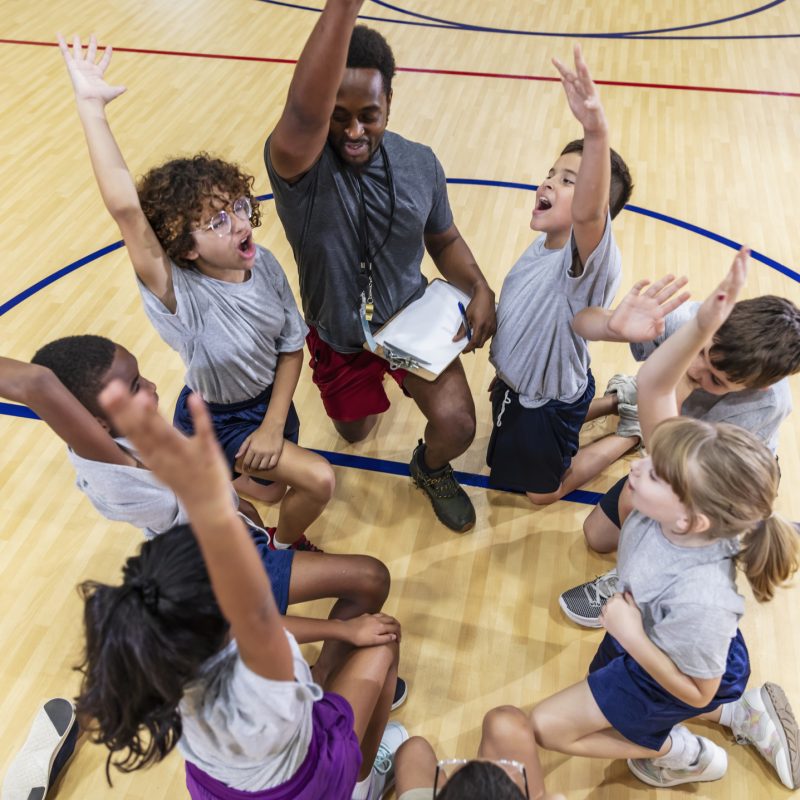
Physical education, from elementary schools to high school to select competitive teams, can serve as more than just a “filler hour” between chemistry and algebra classes, something to meet a state’s Department of Education requirements. Through structured activities, team sports, and cooperative exercises, physical education provides a dynamic environment where students learn to collaborate, communicate effectively, and resolve conflicts— all key components of successful teamwork. In this article we articulate and expand upon the premise that qualities learned in the gym and on the field can pave the way for future leaders in business, corporate management and just about any professional endeavor.
Sports as a Metaphor for Leadership
As personal trainers and fitness professionals, we constantly preach to clients how participation in physical activities can have a profound impact on one’s overall well-being. A newer notion states that sports can confer a strong influence when it comes to sharpening leadership skills.
Physical education helps train future leaders, given its influence on how an athlete thinks and acts, especially when faced with challenges. Regular exercise, sports, and outdoor activities can affect vital aspects of leadership, such as communication, decision-making, strategic thinking, and ethics.
Without Physical education opportunities in schools, students might never get exposed to the following concepts:
- Teamwork ~ Sports activities teach the value of establishing camaraderie, collaboration, and teamwork, all essential factors in becoming a valued team member.
- Decisiveness ~ Participation in team sports trains students to make sound, split-second decisions which benefit the entire team — another valuable skill in a real-life business setting.
- Innovation and Creativity, Power and Authority ~ Team captains train and ultimately excel in proficiently managing a diverse group of people. This requires leveraging strengths/downplaying and eradicating repercussions of weaknesses, proper role delegation and helping the whole team succeed — similar to how a leader functions in a business team.
- Ethics ~ Sportsmanship encompasses more than just winning the game — it translates to honorably pursuing victory by “giving it your best shot”. Potential leaders can learn about integrity, accountability, respect, and fairness through team sports.
The Hidden Gifts of Sports Participation
Many parents encourage and even push their children into joining a sports team, whether they exhibit signs of athleticism or not. While this may come across as placing undue pressure on unwilling youngsters, perhaps parents in the working world know something their children have not considered.
How might the benefits of physical activities translate into enhancing some of the most vital skills essential in effective leadership?
- Better decision-making
- Enhanced problem-solving skills
- Proficient conflict resolution/communication skills
- Increased self-awareness/self-esteem
- Improved creativity and innovation
- Improved job performance/productivity
- Enhanced ethical and moral standards
- Stress reduction
- Improved focus/concentration
Sometimes We Need More Than an MBA
Most of today’s business world, both here as well as across the globe, relies upon the savviness of its employees. Companies often seek out the best and brightest among the top universities and business schools, hoping to provide their companies with the sharpest competitive edge. While this does remain a valid process, we might also recognize that the skills learned through physical education seamlessly transfer to application within academic, professional, and personal contexts.
We can think of a sports team as a small company, and its team captain and coaches the chosen/appointed leaders. The players of this sports team know the value of teamwork and leadership skills, as highly valued in the workplace as on the field. These qualities resonate with employees who find themselves frequently engaging in collaborative projects requiring strong leadership responsibilities. The ability to work well with others, communicate effectively, make strategic decisions, and lead a team comprise essential competencies that can enhance career prospects and professional success. All of these traits likewise get cultivated throughout an entire playing season. For instance, a student who developed leadership skills as captain of the lacrosse team might find himself well prepared to lead a project team in a future business career. Similarly, the teamwork skills honed through sports can figure prominently when collaborating with colleagues on complex tasks, or navigating group dynamics in a corporate setting.
Tapping Into Deeper Areas
Sometimes a baseball game plays out over 9 fairly nondescript innings. At other times, the team’s key slugger stumbles as he rounds second base, twists an ankle, and must sit out the rest of the game. The coach and team captain must now struggle to find a quick and successful way out of this conundrum. By boosting creativity and imagination in leaders, physical education opens up a range of opportunities for individuals in managerial roles to think more innovatively and develop creative solutions for complex issues – something often required from successful corporate leaders.
Furthermore, physical activity contributes to increased self-awareness by providing a platform for introspection. Leaders with good self-awareness can identify their strengths and weaknesses and learn to effectively delegate tasks to others. As a result, they can better lead their teams and make informed decisions that benefit any team within any successful company.
Nurturing Tomorrow’s Successful Leaders
In addition to teamwork, physical education can prove instrumental in nurturing leadership qualities. Assigning roles like team captain or group leader allows individuals to experience decision-making, strategic thinking, and accountability firsthand. These leadership opportunities provide grounds to practice mentoring peers, providing constructive feedback, and making tactical adjustments under pressure. Leadership in sports also involves fostering a supportive and motivating environment, crucial for team success.
Team sports and group activities in any physical education setting may naturally lead to some conflicts. Disagreements may arise over strategy, performance, or decisions made during the game. These situations provide students with practical experiences in conflict resolution. They learn to address issues calmly, negotiate solutions, and maintain respect for one another in spite of differing opinions. Sportsmanship, a key tenet of any competitive sports endeavor, emphasizes fair play, respect for opponents, and graciousness in both victory and defeat. By teaching students the principles of sportsmanship, coaches can foster emotional growth, and help teammates develop respect for their peers as well as their opponents. This further reinforces the idea that healthy competition and mutual respect serve as integral components of strong teamwork.
The Inverse Also Works
Now that we have established a connection between engaging in team sports as a young person and successful leadership and teamwork as an adult, we can also consider the inverse proposition. How can regular exercise (fitness) benefit a successful team leader?
Leaders who have made fitness a regular part of their lives received significantly better performance reviews from their bosses, as well as positive feedback on their leadership capabilities, in comparison to their more sedentary coworkers. Many high-powered executives feel that any time invested in regular exercise equates to spending less time at work, a concept with which they often struggle. However, research indicates that a healthy lifestyle can actually benefit these top leaders, helping to facilitate better coping skills for the stresses and demands of their positions. These strategies ultimately make their leadership more effective.
As coaches and personal trainers, we already believe that exercising and staying healthy does not need to consume a majority of one’s daily free time. According to exercise physiologist Sharon McDowell-Larsen, shorter, multiple bursts of high-energy activity can prove just as beneficial as longer, less intense bouts.
She recommends 3 mini-workouts – resistance band workouts, body weight resistance exercises, and/or 5-minute core workouts –to help combat the stress of leadership. Furthermore, McDowell-Larsen suggests these 4 tips for making exercise a way of life:
- Move less, but more often ~ Short stints of moderate exercise performed daily help maintain energy and boost performance, working better than an hour of exercise performed solely on the weekends. In addition, the latter option tends to create more exercise-related injuries.
- Break up the day ~ Find little ways to increase activity throughout the day: Walk while participating in a conference call on a mobile phone; walk to a coworker’s desk for a question rather than sending an email; park at the far end of the lot; take the stairs instead of the elevator.
- Monitor progress ~ Logging workouts enables one to track progress, set goals, and stay motivated.
- Choose a different exercise modality ~ Instead of hopping on the convenient treadmill or elliptical machine, embrace exercising outdoors: hiking, jogging, biking.
Physical Activity and Self-discipline
Participation in any manner of fitness activities often involves setting goals, maintaining a routine, and developing self-discipline. These skills directly transfer to leadership roles. By engaging in regular exercise, individuals learn the importance of setting achievable goals, breaking them down into smaller steps, and persistently working towards their target goals. Engaging in such processes can cultivate mental fortitude; even seasoned leaders may learn new ways in which to overcome challenges and maintain motivation during those inevitable setbacks.
Communication and Teamwork
Leadership in sports is rooted in communication—both speaking effectively and listening just as effectively. On the competitive sports field, players learn how to share ideas, give directions, and encourage their teammates, all while remaining open to and responding to others. This ability to communicate effectively translates directly to the “office environment”, whether managing a group project at work, resolving a disagreement, or motivating/mentoring a new team member.
Supporting and inspiring Others
A big part of leadership, and a quality only found in the most experienced and driven bosses, lies in recognizing that success of the whole includes helping others reach their potential. The concept of leadership development involves expanding the collective capacity of team members to engage effectively in leadership roles and processes. Possessing and strengthening one’s ability to inspire and uplift others comes as a direct result of skills learned by playing team sports.
Life Beyond the Playing Field
Sports have risen to a place of higher value in today’s educational environment. Lessons learned through participation in team sports evolve into the ability to foster life skills that go well beyond athletic ability.
Sports introduces us, through a controlled setting, to concepts that teach how to resolve the following challenges, whether in a business setting or interpersonal dynamics:
- Handle disagreements ~ As any coach can tell us, disputes over playing time, team responsibilities, or tactical choices commonly occur. Participants must possess the skills needed to engage in open discussions, thereby defusing tension and ensuring the team’s success.
- Cooperate under pressure ~ Seasoned athletes learn composure, optimal ways in which to encourage one another, and the most expedient and fair ways of working toward solutions in potentially high-stress situations like a close game or a difficult loss. Once again, work stress and tensions can only benefit from these early lessons.
- Establish trust ~ Mutual trust, the foundation of all successful teams, develops via teamwork and shared experiences, both on and off the field.
One common feature that unites all various ideas of leadership involves influencing others within the context of a group, and focuses on the attainment of common goals. In today’s concepts of leadership within organizational/work settings, team leadership now gets recognized as a distinct subcategory of organizational leadership.
Leadership development as a fairly new concept separates itself from the more traditional approaches to studying leadership, such as the link between certain personality traits and leadership qualities. Within the leadership development field, some confusion exists between the different but related concepts of leader development and leadership development. According to some professionals, leader development focuses on cultivating the leadership ability of specific individual leaders (a coach or a team captain), whereas leadership development focuses on a process that involves multiple individuals, both leaders and followers, designed to meet the needs of the entire team. In terms of a sports metaphor, this perspective on leadership development endorses the importance of “on the job” learning, with athletes accruing opportunities to develop their leadership abilities in practice and play.
Shared leadership, an emergent team phenomenon, originates from the interaction of all team members. Experts have witnessed an increasing emphasis on the use of leadership groups to meet the perceived needs of the team. In Australia, professional football coaches advocate the use of such groups, believing that players who “own” their leadership can exert a positive impact upon performance both on and off field, and ultimately upon the team’s culture as a whole.
For individuals seeking to use their Personal Trainer/Coach skills in the educational realm, perhaps as a PE teacher or a basketball coach, know that the work you do lays the foundation for tomorrow’s successful entrepreneurs and corporate leaders. Instill within these young minds the values inherent in cooperation, integrity, teamwork and communication. Watch as they mature and succeed in leading us into the future.
References
https://www.ijfans.org/uploads/paper/e6e97dc3a95d2cb8d34ff4979cc3d3c3.pdf
https://www.leadershipchoice.com/link-between-being-a-great-leader-and-exercise/
https://pmc.ncbi.nlm.nih.gov/articles/PMC8892492/
https://journals.humankinetics.com/view/journals/tsp/36/2/article-p101.xml
https://www.sciencedirect.com/science/article/abs/pii/S1469029220307883
https://www.edutopia.org/article/teaching-leadership-skills-4-pe-games/
https://www.ccl.org/articles/leading-effectively-articles/spotlight-on-exercise-and-leadership/






